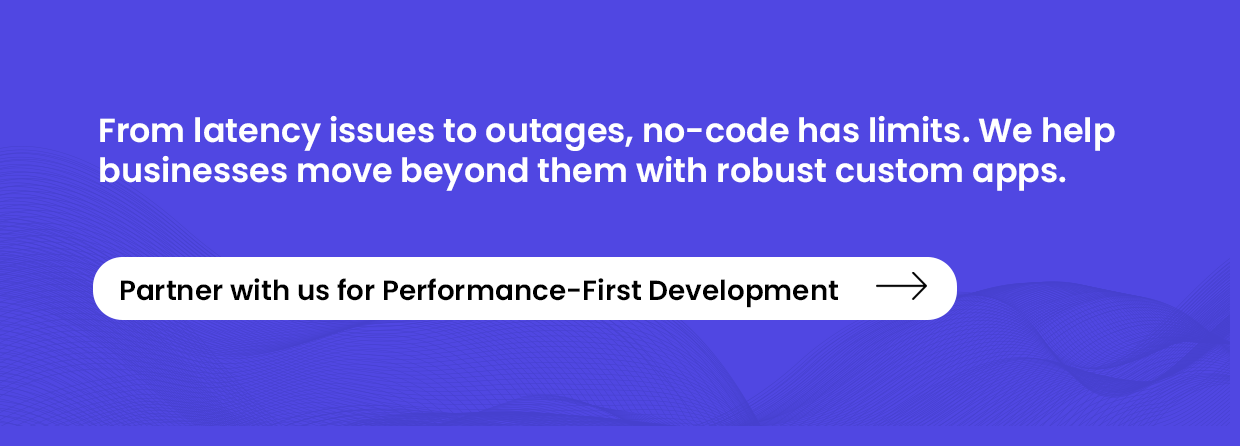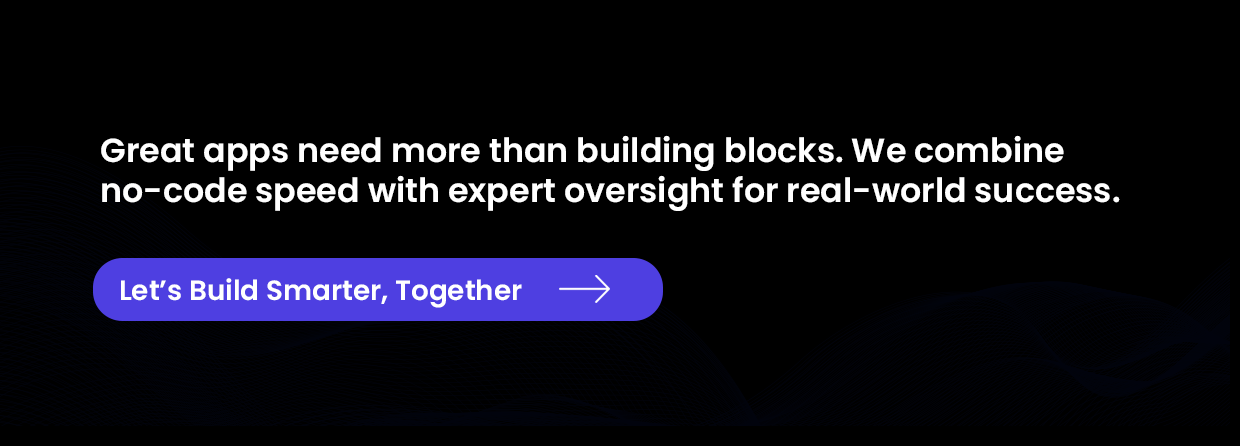
No-code app development has exploded in popularity over the last few years, promising anyone – from solo founders to business teams – the ability to build functional apps without writing a single line of code. The allure is undeniable: faster launches, lower costs, and the democratization of software creation.
But beneath the glossy surface lies a more complicated story. While no-code platforms can accelerate early-stage development, they come with hidden pitfalls that can slow down growth, compromise security, or create costly headaches down the line. In this article, we’ll explore the less talked about limitations of no-code platforms – arming you with the insight needed to make smarter decisions for your projects.
Why No-Code is so Popular
No code app development platforms have revolutionized how apps are built by breaking down traditional barriers in software development. Before no-code, building even a simple app required hiring developers, navigating complex codebases, and enduring long development cycles – often putting early product validation out of reach for many entrepreneurs or small teams.
Today, no-code tools enable anyone with an idea – even without technical expertise – to create functional prototypes or even full-fledged applications. This accessibility empowers startups to move from concept to live product in days or weeks rather than months, significantly accelerating the time-to-market. For businesses, it means they can rapidly experiment with new features or internal tools without the usual overhead of IT projects.
Another key driver of no-code’s popularity is cost efficiency. Traditional development demands upfront investment in skilled developers, project managers, and QA testers. No-code platforms reduce these costs by offering drag-and-drop interfaces, pre-built components, and integrations that handle many backend complexities behind the scenes. This shift lowers financial risk, making MVPs and internal tools more affordable to build and iterate on.
Furthermore, no-code platforms often come with extensive ecosystems of templates, plugins, and third-party services, which make customization accessible for non-coders. Users can integrate payment gateways, analytics, databases, and automation tools with relative ease, opening up new possibilities for lean product development.
All these benefits combined have made no-code the darling of early-stage innovation and business agility. Yet, while no code app development excels at speed and accessibility, these very strengths can also sow the seeds of future challenges – especially as products scale and require more control, security, and performance.
Hidden Limitations of No-Code Platforms
For all their promise, no-code platforms are not without constraints. In fact, many of the qualities that make them so appealing in the beginning can quietly become liabilities as the product grows or the use case becomes more complex.
One of the most commonly known dark side of no-code app development is customization. No-code tools offer pre-built components and visual logic flows, but they’re rarely flexible enough to handle niche use cases or advanced feature sets. Need a highly tailored recommendation engine? A real-time collaboration feature? A custom-built API interaction that isn’t in the platform’s library? Chances are, you’ll hit a wall – and retrofitting these capabilities into a no-code architecture often leads to clunky workarounds or complete rebuilds using traditional development.
There’s also the matter of code quality and debugging. Since the platform abstracts the codebase, you often don’t have visibility into what’s actually running under the hood. When things go wrong, you’re at the mercy of support documentation or the community – there’s no direct way to dig into the logic, fix a bug, or run advanced tests.
And finally, as your product becomes more complex, the once-tidy visual logic can spiral into a tangled mess. What started as a clean drag-and-drop flow can turn into an unmanageable network of dependencies that’s harder to maintain than actual code.
In short, no-code can be incredibly effective for launching fast and validating ideas – but the moment your needs go beyond the boundaries of what the platform was designed to do, you start to see the cracks. And by then, switching away from it isn’t always easy, surfacing a dark side of no-code app development.
Security and Compliance Risks
While speed and accessibility are key selling points of no-code platforms, they often come at the expense of rigorous security and compliance controls. This trade-off may not be obvious at first, but it can pose serious hidden risks of no-code app builders – especially for startups handling sensitive data or operating in regulated industries.
For starters, data security on no-code platforms is largely out of your hands. You don’t control the hosting environment, encryption standards, or how user data is stored and transferred. Most no-code tools are cloud-based, meaning sensitive customer data might sit on third-party servers with shared tenancy – creating potential vulnerabilities if the provider is breached or if access controls aren’t airtight.
Then there’s compliance. If your app needs to meet specific regulatory requirements like HIPAA, GDPR, SOC 2, or PCI DSS, relying on a no-code platform can quickly get tricky. Many of these platforms don’t offer granular enough control to enforce compliance at a technical level. They may lack audit logs, access-level segmentation, or data residency options – all of which are critical for meeting regulatory obligations. And even when platforms claim compliance support, it’s often your responsibility to verify and configure everything correctly, which isn’t easy without technical expertise.
Authentication and authorization are other weak points. While most no-code tools offer basic user login flows, advanced requirements like multi-factor authentication, role-based permissions, or custom OAuth integrations may be unsupported or difficult to implement securely. This leaves your application vulnerable to misuse or unauthorized access.
Also, consider third-party integrations – which no-code apps often rely heavily on. Every plugin or automation you add introduces another point of exposure. And because users may not have the technical knowledge to assess these integrations properly, it’s easy to create configurations that accidentally leak data or bypass security best practices.
The most pressing issue, however, is limited visibility and control. When something goes wrong – whether it’s a data breach, service outage, or compliance failure – you don’t have access to server logs or system-level information to understand or fix the problem. You’re reliant on the platform’s support team, which may not respond quickly enough in mission-critical situations.
In essence, while no code app development might be good enough for building a quick prototype or internal tool, the moment your app starts dealing with private user data, financial transactions, or regulated workflows, the security and compliance risks escalate significantly. And unless these concerns are addressed early on, they can lead to both reputational damage and legal consequences.
Performance and Reliability Concerns
No-code platforms shine in the early stages – when you’re testing an idea, building a lightweight MVP, or spinning up a simple internal tool. But once your app gains traction, performance and reliability become crucial, and that’s where the cracks often start to show, tilting the no code vs custom development scale to custom.
Most no-code platforms are built on shared cloud infrastructure, meaning your app is running alongside thousands of others. While this setup keeps costs low, it can also cause your application to slow down unexpectedly, especially during peak traffic hours. Unlike custom-built apps where performance can be tuned and scaled with precision, you’re at the mercy of how the platform allocates resources – something you have little control over.
Another limitations of no-code platforms is latency and load times. As your app grows in complexity, so does the number of logic flows, integrations, and frontend elements being processed. What started off as a snappy prototype can become sluggish, with delayed responses, bottlenecks, and screen flickers that frustrate users and hurt retention.
Moreover, downtime and service outages are rarely under your control. If your no-code provider experiences a system failure, your app is affected – regardless of how mission-critical it may be. There’s typically no way to spin up backup servers or reroute traffic as you could with traditional cloud setups. And depending on your pricing tier, support may be limited or slow to respond during outages.
Apps with real-time functionality – like live chats, collaborative editing, or live updates – also tend to push no-code platforms beyond their comfort zones. These features demand low-latency processing, websocket connections, and efficient backend architectures – most of which are either unsupported or extremely limited in no-code tools.
And finally, the reliance on third-party plugins and APIs to extend functionality can become a performance bottleneck. Each external service introduces potential failure points and increases latency. If one of these services goes down or slows down, your app suffers, and you often have limited means to debug or mitigate the issue.
In essence, no-code platforms work best when app performance is not a critical business factor. But if you’re building something where speed, reliability, and user experience are non-negotiable, traditional or hybrid development is often a more future-proof path.
Scaling Issues and Long-Term Viability
One of the most underestimated drawbacks of no-code development is its limited capacity to support long-term growth. While it’s fantastic for getting a product off the ground, scaling that product – across users, features, and markets – often reveals serious constraints.
Architecture limitations are at the heart of the hidden risks of no-code app builders. No-code platforms are built to abstract technical complexity, which makes them inherently rigid beneath the surface. As your application’s logic becomes more nuanced or your data handling more sophisticated, you may find the platform’s architecture simply isn’t designed to support the level of control or performance your use case now demands.
As user adoption grows, so does the need for efficient database queries, asynchronous processing, background jobs, and optimized API calls. Most no-code platforms don’t give you the ability to manage these things directly. You’re stuck relying on the platform’s default methods – many of which aren’t optimized for high-volume scenarios.
You also run into problems when trying to implement modular, maintainable code practices. With no-code, logic is usually spread out across visual workflows, often without version control, testing pipelines, or CI/CD integrations. When your team grows and multiple people start working on the app, collaboration becomes chaotic – and maintaining a stable release cycle gets harder over time.
From a product strategy standpoint, these hidden risks of no-code app builders mean you’re also constrained when it comes to launching advanced features or evolving your business model. Want to integrate machine learning? Need to build a native mobile experience with deep OS-level access? Looking to offer custom dashboards for enterprise clients? You’ll often find yourself hacking together third-party tools or reaching the ceiling of what your no-code platform can do – only to realize it may be easier to rebuild the entire app in code.
And then there’s technical debt. Every shortcut you take in no code app development becomes harder to unwind later. Refactoring an app built entirely on a proprietary platform is not like updating a codebase – it often means starting from scratch, migrating data manually, and retraining your team.
Ultimately, no-code can be an excellent springboard – but treating it like a long-term product infrastructure is risky. If scaling is even a remote goal, it’s worth planning from day one how and when you’ll make the jump to more flexible, sustainable architectures.
The Myth of “No-Code = No Expertise Needed”
One of the most seductive promises of no-code tools is that anyone can build an app – no developer, no problem. And while it’s true that these platforms lower the technical barrier, they don’t eliminate the need for expertise. In fact, the idea that no-code equals no-skills-needed is not just misleading – it can be dangerous for product quality and business outcomes.
Let’s start with product thinking. Knowing how to drag and drop components doesn’t mean you understand user experience, system design, or customer psychology. Without a clear sense of product strategy and user flows, it’s easy to build something that technically works but doesn’t solve the problem well – or worse, confuses and alienates users.
Then there’s logic and architecture. Even though you’re not writing code, you’re still defining workflows, setting conditions, handling edge cases, and managing state. Complex apps built on no-code platforms often require the same logical clarity and foresight as traditional development. Without that, things break – fast. And debugging a broken visual workflow with dozens of steps is no walk in the park.
Data modeling and privacy are also often mishandled in no-code projects. Just because you can create a database in a few clicks doesn’t mean you’ve designed it well. Poor schema design, inefficient queries, or insecure handling of sensitive data can lead to performance lags, data breaches, or compliance issues – issues that are hard to spot without technical knowledge.
Even design matters more than people expect. No-code platforms give you building blocks, not finished experiences. If you don’t understand layout grids, typography, responsiveness, or accessibility standards, you’ll end up with a clunky UI that users will abandon quickly.
And finally, scalability, security, and maintenance – all vital parts of long-term success – require critical thinking beyond the platform’s interface. Knowing when the limitations of no code app development are close or how to architect for future growth, is not something a drag-and-drop builder can do for you.
So while no-code does democratize software creation, it doesn’t replace the need for expertise – it just shifts where that expertise is applied. Successful no-code products still demand thoughtfulness, planning, and often a hybrid team with both technical and business skills. The myth of “no-code means no professionals needed” leads to more failed apps than most founders would like to admit.
When No-Code Makes Sense (and When It Doesn’t)
In the no code vs custom development comparison, no-code isn’t inherently bad. In fact, it can be a powerful tool – when used for the right reasons and in the right context. The key is knowing when it fits your goals and when it starts becoming a liability.
No-code makes the most sense during the ideation and MVP stages. If you need to validate an idea quickly, test product-market fit, or build a clickable prototype for investor meetings, no-code can save time and money. Platforms like Bubble, Glide, or Webflow are great for spinning up a usable product in days, not months – especially if you’re a solo founder or a small team with limited dev resources.
It also works well for internal tools or process automation, where the focus is utility over scale. Many operations teams use no-code to connect data sources, build dashboards, or automate workflows that would otherwise need dev support. Here, speed and flexibility matter more than performance or polish, and no-code delivers exactly that.
However, the story changes as soon as customization, performance, or scalability become priorities. If your app needs complex business logic, handles sensitive user data, or is built for a wide and growing user base, relying on no-code can introduce risks you can’t afford. These platforms aren’t built to handle intricate backend logic, high concurrency, or deep integrations with other systems.
Also, if you’re in a highly regulated industry – like healthcare, finance, or education – compliance and data control become critical. Most no-code platforms don’t give you full visibility into how and where your data is stored, or the ability to implement fine-grained security controls.
And if your product roadmap includes AI, real-time collaboration, native mobile experiences, or custom APIs, you’ll likely hit a wall fast. These capabilities often require deeper system-level access or architecture decisions that no-code platforms simply aren’t built for.
In short:
- Use no-code when speed matters more than scale.
- Use no-code when testing ideas, not executing full-scale strategies.
- Avoid no-code when your app is the core of your business, not just a supporting tool.
Making the right call isn’t about tech snobbery. It’s about building responsibly for the stage you’re in – and preparing for what comes next.
No code app development platforms have undeniably changed the game – lowering the barrier to entry for entrepreneurs, speeding up prototyping, and empowering non-developers to build. But like any tool, their value depends on how, when, and why you use them.
The danger isn’t in the platforms themselves, but in treating them as a silver bullet. Building software – whether through code or no-code – still demands strategy, product thinking, and a clear vision for where you’re headed. Scaling, maintaining, and evolving a product takes foresight, and that’s where many no-code journeys start to unravel.
If your goal is to test ideas quickly, automate workflows, or create stopgap tools, no-code is often the fastest path. But if you’re building a core product meant to last, it’s worth asking tough questions early. What are the long-term costs? Will you outgrow the platform? How easy is it to move off when that happens?
No-code is part of the toolkit – but not the whole toolbox. Choose it when it serves your goals, but don’t let it define them.
FAQs.
Q. What are the limitations of no-code app development?
Ans. No-code platforms are great for speed and simplicity, but they often lack the flexibility needed for highly custom features, complex backend logic, or deep integrations. You’re also limited by the platform’s capabilities, which can become a bottleneck as your app grows in complexity.
Q. Can no-code platforms scale for growing businesses?
Ans. To a point, yes. Many no-code tools support decent scale for MVPs and early-stage growth. But as user load, data complexity, or feature demands increase, most businesses eventually hit a ceiling, requiring either costly workarounds or migration to a custom-coded solution.
Q. Why do some developers avoid no-code tools?
Ans. Developers often avoid no-code because of limited control, vendor lock-in, and difficulty debugging issues under the hood. For apps that require performance optimization, security customization, or non-standard features, traditional coding offers more freedom and long-term maintainability.
Q. What are the hidden risks of no-code apps?
Ans. Hidden risks include platform dependency, data export limitations, limited customization, and unpredictable pricing as you scale. Additionally, if the platform shuts down or changes policies, your app could be at risk unless you’ve planned an exit or migration strategy.
Q. How does no-code development affect app performance?
Ans. Performance can be solid for basic use cases, but no-code apps often carry extra load from generic codebases and third-party dependencies. This can result in slower response times, especially for dynamic or data-heavy apps with high traffic.
Q. What security concerns exist with no-code platforms?
Ans. No-code platforms often abstract away security controls, which can be a double-edged sword. You may have limited visibility into how data is stored or transmitted, and fewer options to implement custom security protocols, especially for regulated industries.
Q. What should startups know before choosing no-code?
Ans. Startups should view no-code as a launchpad, not a forever solution. It’s ideal for MVPs or testing ideas quickly, but may not support long-term flexibility or scale. Evaluate platform limits, exportability, pricing structure, and what it would take to rebuild later if needed.



